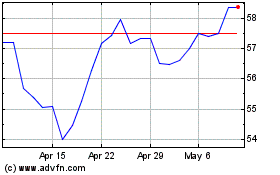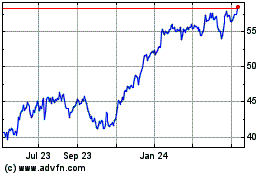Fed's Dudley: Giving More Firms Access to Discount Window 'Worth Exploring'
May 01 2016 - 9:00PM
Dow Jones News
Federal Reserve Bank of New York President William Dudley said
the powers the central bank can use to step in and aid a faltering
financial institution are still flawed, more than seven years after
the crisis, and that allowing more firms access to the discount
window "might be worth exploring."
In a speech Sunday kicking off the Atlanta Fed's annual
conference on financial markets in Amelia Island, Fla., Mr. Dudley
said global regulators were focused on plugging gaps in those
mechanisms, known as lender-of-last resort powers, but more work
was needed.
"In my view, an important issue is to identify and address gaps
in the lender-of-last-resort function," he said. "In the U.S., some
significant gaps remain."
He added, "I am happy to report that the Committee on the Global
Financial System—one of the Bank for International Settlements'
central bank groups—is engaged in a project to determine what
lender-of-last-resort gaps currently exist, focusing, in
particular, on those that may create vulnerability in terms of
financial stability."
One area he expects the group to focus on heavily, he added, is
how those procedures would work in the event a failing firm had
several units operating across international borders. In that case,
the expectations of the domestic and host countries would need to
be properly understood, he said.
In the speech, Mr. Dudley also said regulations crafted since
the financial crisis have done much to safeguard the largest
lenders in the U.S., but he said more work was needed to study the
potential side effects, in particular on the ease of trading.
Now that the rules have made all major securities firms in the
U.S. part of bank holding companies subject to routine capital and
safety checks, Mr. Dudley said providing these firms with access to
the discount window could be a worthwhile addition. Currently, the
Fed's discount window is only available to depository institutions,
and the law hampers the ability of a bank to pass along discount
window funding to its securities unit.
"To me, this is a more reasonable proposition now than it was
prior to the crisis, when the major dealers weren't subject to
those safeguards," he said.
Overall, Mr. Dudley said in the speech, market liquidity—or the
ability to transact securities easily in large sizes and at
reasonable sizes and costs—has worsened in some ways since the
financial crisis, but may have actually improved in others.
He said it isn't clear that rules have been the most important
driver behind those shifts, but acknowledged that the rules had
played a role. Existing studies on the changes, he said, were
insufficient because the metrics available so far "don't tell the
whole story."
"While increases in regulatory requirements have undoubtedly
played a role, I think that other nonregulatory factors are also
important," he said.
Write to Katy Burne at katy.burne@wsj.com
(END) Dow Jones Newswires
May 01, 2016 20:45 ET (00:45 GMT)
Copyright (c) 2016 Dow Jones & Company, Inc.
Bank of New York Mellon (NYSE:BK)
Historical Stock Chart
From Mar 2024 to Apr 2024

Bank of New York Mellon (NYSE:BK)
Historical Stock Chart
From Apr 2023 to Apr 2024
